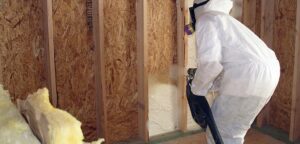Retrofitting insulation in older homes can be one of the most effective ways to boost comfort and lower utility bills. In Nashville, where weather swings from hot, humid summers to chilly winters, many homeowners are turning to blown-in insulation as a practical solution for existing wall structures. This method enhances thermal performance with minimal disruption to interior finishes.
Blown-in insulation—whether cellulose or fiberglass—can be inserted into wall cavities through small holes, making it especially ideal for homes that weren’t built with modern insulation standards. But before diving into installation, it’s important to understand the structural readiness of your walls, what type of insulation best fits your environment, and what the retrofit process involves.
This article breaks down everything Nashville homeowners need to know, including wall cavity assessment, material selection, climate-specific tips, and how to avoid common pitfalls.
Understanding Blown-In Insulation for Retrofits
Blown-in insulation contractors in Nashville uses loose-fill materials that are pneumatically blown into wall cavities using specialized equipment. This method helps fill irregular gaps and voids that traditional batt insulation might miss.
Key Advantages of Blown-In Insulation:
- Fills irregular spaces and penetrates tight gaps
- Requires minimal demolition for installation
- Boosts home energy efficiency and thermal performance
- Reduces outside noise and enhances indoor acoustics
Compared to removing drywall or siding, blown-in methods preserve much of the home’s existing structure. It’s a relatively non-invasive approach ideal for upgrades in older Nashville properties.
Key Materials Used in Blown-In Wall Insulation
Blown-in insulation typically comes in two materials: cellulose and fiberglass. Each offers distinct advantages depending on your home’s needs and local climate conditions.
| Material | R-Value per Inch | Fire Resistance | Moisture Resistance | Common Use |
| Cellulose | 3.2 – 3.8 | Moderate | Low | Interior walls |
| Fiberglass | 2.2 – 2.9 | High | Moderate | Exterior walls |
Bonus Tip:
In Nashville’s humid summers, fiberglass may perform better in preventing mold and moisture-related issues due to its non-organic composition.
Cellulose, on the other hand, offers a greener option made from recycled materials. It’s also denser, making it an excellent sound dampener.
Technical Specs to Know
Understanding the technical aspects helps you align your retrofit with Nashville’s building efficiency standards.
| Property | Description |
| R-Value Goal (Walls) | R-13 to R-21 (depends on structure) |
| Minimum Wall Cavity | 3.5 inches |
| Installation Method | Dense pack (recommended for retrofits) |
| Air Sealing Needed? | Yes, before insulation is added |
Dense packing ensures the material resists settling over time. Proper air sealing prior to installation helps prevent drafts and moisture infiltration.

Key Factors for a Successful Retrofit
Several factors influence the effectiveness of a blown-in insulation retrofit. Understanding these can help prevent post-installation issues.
1. Wall Cavity Type
- Empty stud cavities: Best suited for blown-in applications
- Partially insulated: May require removal of old material
- Obstructed cavities: Pipes, wiring, or fire blocking can complicate fill
2. Access Method
- Interior access: Holes are drilled inside walls and patched post-installation
- Exterior access: Entry through siding reduces indoor cleanup but may affect curb appeal
3. Age and Condition of Walls
Homes built before the 1980s may have:
- Irregular spacing between studs
- Non-standard cavity depths
- Plaster-and-lath walls requiring extra care
Things to Consider Before Choosing Insulation
Evaluate Nashville’s Climate Needs
Nashville’s climate includes intense summer heat and periodic winter freezes. Insulation contractors in Nashville seek through it so that the insulation can be effective across all seasons.
Inspect for Adequate Ventilation
Adding insulation without proper ventilation can trap moisture. Attic and wall vents should be checked or added if necessary.
Explore Local Rebates and Incentives
Tennessee Valley Authority (TVA) and local utility companies may offer rebates for energy efficiency upgrades, including insulation.
Assess Wall Surface Materials
Different exterior finishes require different drilling methods:
- Brick or stucco: Professional masonry access needed
- Vinyl or wood siding: Easier to remove and replace
Bonus Tip:
Check for existing knob-and-tube wiring if your home is older. It may not be safe to cover with insulation and might require electrical upgrades first.

Comparing Blown-In to Other Wall Insulation Types
| Feature | Blown-In | Spray Foam | Batt Insulation |
| Retrofit-Friendly | Yes | Moderate | No (requires teardown) |
| Air Sealing | Moderate | Excellent | Low |
| Installation Cost | Moderate | High | Low |
| Moisture Resistance | Moderate | High | Low to Moderate |
Blown-in insulation provides a middle-ground solution—easier to install than spray foam and more effective than batts for retrofits.
Bonus Tip:
In older homes where spray foam might cause moisture lock-in, blown-in cellulose or fiberglass provides a breathable option that balances air flow and insulation.
Common Homeowner Questions
Nashville homeowners frequently wonder:
- Will I notice a difference in temperature control?
Yes—rooms become noticeably more stable in temperature and quieter. - Is this a messy process?
While insulation blowing can be dusty, professionals use containment systems to reduce mess. - Can retrofitting be done during winter?
Yes, especially if interior access is used. - Will insulation reduce my energy bill?
Most homeowners see 15–25% reductions in heating and cooling costs. - What if I plan to remodel later?
Retrofits can be coordinated with future remodels to avoid duplication of work.
Frequently Asked Questions About Home Insulation
- What is the best insulation for existing walls?
Blown-in cellulose and fiberglass are top choices for non-invasive retrofits that don’t require wall demolition. - Can insulation be added without removing drywall?
Yes, through small holes drilled in the wall surface, which are patched after installation. - How long will the installation take?
Typically one to three days, depending on the home’s size and wall accessibility. - Will insulation stop drafts completely?
It will significantly reduce them, especially when paired with proper air sealing. - Does insulation settle over time?
Dense-packed materials settle less and maintain performance longer.
Finding the Right Insulation Expertise
Choosing blown-in insulation for existing walls is an efficient way to improve comfort, cut energy waste, and modernize older homes in Nashville. With the right materials and preparation, retrofits can be completed quickly and with minimal disruption.
For homeowners seeking professional guidance or services ,Armored Insulation is a provider with experience in this field. Readers can learn more about Armored Insulation’s services:
Company: Armored Insulation
Phone: (270) 727-5566
Email: [email protected]









